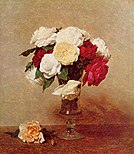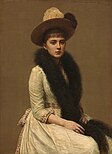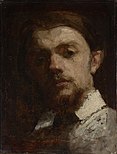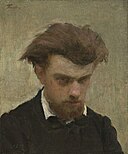Henri Fantin-Latour (original) (raw)
From Wikipedia, the free encyclopedia
French painter (1836–1904)
| Henri Fantin-Latour | |
|---|---|
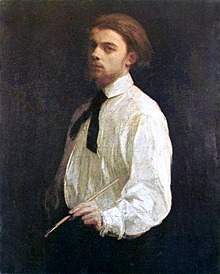 Self-portrait (1859), Museum of Grenoble Self-portrait (1859), Museum of Grenoble |
|
| Born | (1836-01-14)14 January 1836Grenoble, France |
| Died | 25 August 1904(1904-08-25) (aged 68)Buré, France |
| Resting place | Cimetière du Montparnasse |
| Nationality | French |
| Education | École des Beaux-Arts |
| Movement | Realism, symbolism |
| Spouse | Victoria Dubourg |
Henri Fantin-Latour (French pronunciation: [ɑ̃ʁi fɑ̃tɛ̃ latuʁ]; 14 January 1836 – 25 August 1904) was a French painter and lithographer best known for his flower paintings and group portraits of Parisian artists and writers.[1]
Born in Grenoble, Isère, Ignace Henri Jean Théodore Fantin-Latour first had drawing lessons with his father Théodore Fantin-Latour (1805-1875), who was a painter.[2] In 1850 he moved to Paris where he enrolled in the small Paris School of Drawing, where he studied with Louis-Alexandre Péron and Horace Lecoq de Boisbaudran, an innovative and non-traditional instructor who developed his own teaching method based on painting and drawing from memory.
He entered the École des Beaux-Arts, in Paris, in 1854, where he had for classmates, Edgar Degas, Alphonse Legros and Jean-Charles Cazin. After studying there, he spent long time copying the works of the old masters in the Musée du Louvre.[2] Although Fantin-Latour befriended several of the young artists who would later be associated with Impressionism, including Whistler and Manet, his own work remained conservative in style.[2]
In 1861, he briefly frequented the studio of Gustave Courbet. A painting from this period represents him with the painter and caricaturist Oulevay.
At the start of his career, between 1854 and 1861, he produced a large number of self-portraits in chalk, charcoal and oil. He had one of them refused at the Salon of 1859. He participated again with La Liseuse in 1861.
A member of the so-called Cénacle des Batignolles, or group of 1863, from where from Impressionism originated, he was, according to Gustave Kahn, a kind of the link between their painters and romantic painting.
In 1862, one of his still lifes was exhibited at the Royal Academy in London. It was the first of a long series, for thereafter he presented several almost every year and which invariably occupied a prominent place in the exhibition building. During his third trip to England, from July to October 1864, he once again painted still lifes there. He had commercial success.
The 1860s and his still lifes
[edit]
Encouraged by American painter James McNeill Whistler (1834-1903), whom he met in 1858 at the Louvre, he made several stays in London from 1859 to 1881. In the 1860s, he cultivated the genre of the still life, who would play a capital role in his career.[2] Fantin-Latour would find recognition in England for his compositions of flowers and fruits, at a time when French Impressionist painting was still not very widely there. It was said that his still lifes were "practically unknown in France during his lifetime".[2] Thanks to Whistler he met his brother-in-law Francis Seymour Haden and the engraver Edwin Edwards, and it was in London that he learned engraving.[3]
His decision to make still lifes may seem surprising at the time of Impressionism, however, the choice of such a subject wasn't innocent. In the hierarchy of genres enacted by the Academy of Fine Arts since the 17th century, the still life of fruit or flowers was considered a minor category. By ignoring any literary, religious or historical context, supposed to confer value and nobility on the work, he adopted the opposite stance of academicism. Edwin and Ruth Edwards, his English patrons and merchants, recommended that he always used simple vases and table tops in order to exhibit his great talent in rendering texture and color.[4]
Fantin-Latour still lifes were also very appreciated in the Netherlands at his time. At the Living Masters Exhibition in Amsterdam, in 1889, one of his still lifes with roses sold by 2,000 guilders, a considerable sum back then. Dutch art dealers from Amsterdam regularly sold works by Fantin-Latour well into the 1930s. Many of these works would end in Dutch museums such as the Rijksmuseum, in Amsterdam, and the Kröller-Müller Museum, in Otterlo.[5]
After his first Salon submissions were rejected in 1859, he began exhibiting with his friend Édouard Manet and the future Impressionists Pierre-Auguste Renoir and Claude Monet. In 1865, he wrote to Edwin Edwards : “We form a group and make noise because there are many painters and one is easily forgotten. When we come together... we grow in numbers and become more adventurous. I thought it could last, it was my mistake”.[6]
In 1867, he was also one of the nine members of the Japanese Jinglar Society, with Carolus-Duran, who painted his portrait twice in 1861, and the ceramists Bracquemond and Solon, who they met to dinner at the Japanese style. “One always felt when approaching him, a small feeling of fear, because of these rough manners which the artists of his generation often affected as inseparable from a noble independence”, would say Jacques-Émile Blanche, a friend painter of the following generation.[7]
Fantin renovated the collective portraiture with paintings who served as large manifestos: Homage to Delacroix (1864), A Studio at Les Batignolles (1870), a tribute to Manet, The Corner of the Table (1872), a homage to the Parnassian poets, including Paul Verlaine and Arthur Rimbaud, and Around the Piano (1885), a tribute to musicians and musicologists of his time.[3]
In A Studio at Les Batignolles, Manet is depicted in the center in the act of painting, while he is surrounded of several important painters and writers, including Pierre-Auguste Renoir, Zacharie Astruc, Emile Zola, Frédéric Bazille and Claude Monet. This canvas testifies to the links he maintained with the artistic and literary avant-garde of the time and to Manet in particular; it also seems to be an echo of Zola s opinion of Manet: "Around the painter reviled by the public, a common front has been created of painters and writers claiming him as a master".
In addition to his realistic paintings, Fantin-Latour created imaginative lithographs inspired by the music of some of the great classical composers. In 1876, Fantin-Latour attended a performance of the Ring cycle at Bayreuth, which he found particularly moving.[8] He would later publish lithographs inspired by Richard Wagner in La revue wagnérienne, which helped solidify his reputation among Paris' avant-garde as an anti-naturalist painter.[8]
In 1876, Fantin-Latour married a fellow painter, Victoria Dubourg, whom he met when both were copying the same painting at the Louvre.[9] He would spend his summers on the country estate of his wife's family at Buré, Orne in Lower Normandy, where he died on 25 August 1904.[10]
Like many painters of his time, he became interested in photography, taking pictures for his work. He was also a big collector of erotic photographs; his estate lists more than 1,400 which are kept in the Museum of Grenoble.[11]
He was interred in the Cimetière du Montparnasse, Paris, France.
Marcel Proust mentions Fantin-Latour's work in In Search of Lost Time:
"Many young women's hands would be incapable of doing what I see there," said the Prince, pointing to Mme de Villeparisis's unfinished watercolours. And he asked her whether she had seen the flower painting by Fantin-Latour which had recently been exhibited. (The Guermantes Way)
His first major UK gallery exhibition in 40 years took place at the Bowes Museum in April 2011.[12] Musée du Luxembourg presented a retrospective exhibition of his work in 2016–2017 entitled "À fleur de peau".
A reproduction of the painting A Basket of Roses was used as the cover of New Order's album Power, Corruption & Lies by Peter Saville in 1983.
Nine artworks by Fantin-Latour are listed concerning their Nazi-era provenance on the Lost Art Foundation website.[13]
Flower paintings

Still Life with Flowers, Fruits, Wineglass and a Tea Cup (1865)Other still lifes

Still Life with Mustard Pot (1860), National Gallery of Art
Figues, Reine-Claude et abricot (1864), Mougins Museum of Classical ArtPortraits and allegorical paintings

Mr. and Mrs. Edwards (1875), Tate Gallery
Dubourg Family (1878), Musée d'Orsay
Portrait of Charlotte Dubourg (1882), Paris, musée d'OrsaySelf-portraits
Art Gallery of the University of Rochester (New York)
Arthur Ross Gallery (University of Pennsylvania)
Bowes Museum (County Durham, England)
Fondation Bemberg Museum (Toulouse, France)
La Piscine (Roubaix, France)
MacKenzie Art Gallery (Regina, Saskatchewan)
Montreal Museum of Fine Arts, (Canada)
Museum of Grenoble (France)
Musée de Picardie (Amiens, France)
Musée des Beaux-Arts de Bordeaux (France)
Musée des Beaux-Arts de Lyon (France)
Musée des Beaux-Arts (Reims, France)
Museum Geelvinck (Amsterdam, Netherlands)
Musée des Beaux-Arts de Rouen (France)
Musée des Ursulines [fr] (Mâcon, France)
Université de Liège Collections (Belgium)
- ^ Rosenblum 1989, p. 162.
- ^ a b c d e Poulet & Murphy 1979, p. 73.
- ^ a b Gustave Kahn, Fantin-Latour, Paris, Rieder, 1926 (French)
- ^ Jean-Louis Roux, "Des pétales au bout du pinceau", in Les Affiches de Grenoble et du Dauphiné, no 4594, 21 September 2012, pp. 132-133 (French)
- ^ Boimans van Beuning Museum, Rotterdam
- ^ Edward Lucie-Smith, Henri Fantin-Latour, Rizzoli, 1977, p. 13
- ^ Jacques-Émile Blanche, "Fantin-Latour", Revue de Paris, 1906, pp. 289-313 (French)
- ^ a b Sloan, Rachel (2009). "The Condition of printmaking: Wagnerism and printmaking in France and Britain". Art History. 32 (3): 545–577. doi:10.1111/j.1467-8365.2009.00681.x.
- ^ Crawford, Amy (January–February 2025). "Feast Your Eyes on These Paintings From the Impressionist Era". Smithsonian Magazine. Retrieved 3 January 2025.
{{[cite news](/wiki/Template:Cite%5Fnews "Template:Cite news")}}: CS1 maint: url-status (link) - ^ Edward Lucie-Smith, Henri Fantin-Latour, Rizzoli, 1977
- ^ "Au musée du Luxembourg, les photos licencieuses de Fantin-Latour", Lefigaro.fr, 12 September 2016 (French)
- ^ "A Bed of Roses: Fantin-Latour and the Impressionists at the Bowes Museum". Thebowesmuseum.org.uk. Archived from the original on 14 April 2011. Retrieved 17 September 2013.
- ^ "Fantin-Latour, Henri Suche | Lost Art-Datenbank". www.lostart.de. Retrieved 1 November 2023.
- ^ "drawing | British Museum". The British Museum. Retrieved 12 March 2021.
- ^ "Fantin-Latour: Independent Artist, Friend of the Impressionists" (PDF). Archived from the original (PDF) on 31 August 2021. Retrieved 12 March 2021.
- ^ "Art | Hammer Museum". hammer.ucla.edu. Retrieved 12 March 2021.
- ^ "Henri Fantin-Latour (French, 1836 - 1904) (Getty Museum)". The J. Paul Getty in Los Angeles. Retrieved 12 March 2021.
- ^ "Henri Fantin-Latour | MoMA". The Museum of Modern Art. Retrieved 12 March 2021.
- ^ "Larkspurs - FANTIN-LATOUR, Henri". Amgueddfa Cymru – Museum Wales. Retrieved 12 March 2021.
- ^ "White and Pink Mallows in a Vase » Norton Simon Museum". www.nortonsimon.org. Retrieved 12 March 2021.
- ^ "Asters in a Vase". Saint Louis Art Museum. Retrieved 12 March 2021.
- ^ "Fantin-Latour, Henri". Museo Nacional Thyssen-Bornemisza. Retrieved 12 March 2021.
- ^ "Flowers and Fruit". emuseum.toledomuseum.org. Retrieved 12 March 2021.
- ^ "Exchange: A Victor Hugo". exchange.umma.umich.edu. Retrieved 12 March 2021.
- ^ "Flowers from Normandy Henri Fantin-Latour, 1887". Van Gogh Museum. Retrieved 12 March 2021.
- ^ "Bouquet of Zinnias (Primary Title) - (83.22)". Virginia Museum of Fine Arts |. Retrieved 12 March 2021.
- Chisholm, Hugh, ed. (1911). "Fantin-Latour, Ignace Henri Jean Théodore" . Encyclopædia Britannica. Vol. 10 (11th ed.). Cambridge University Press. p. 172.
- Gibson, Frank F., The art of Henri Fantin-Latour, his life and work, London, Drane's ltd., 1924.
- Lucie-Smith, Edward, Henri Fantin-Latour, New York, Rizzoli, 1977.
- Poulet, Anne L., & Murphy, A. R., Corot to Braque: French Paintings from the Museum of Fine Arts, Boston, Boston: The Museum, 1979. ISBN 978-0-87846-134-9
- Rosenblum, Robert, Paintings in the Musée d'Orsay, New York: Stewart, Tabori & Chang, 1989. ISBN 978-1-55670-099-6
- 96 artworks by or after Henri Fantin-Latour at the Art UK site
- Henri-Fantin-Latour.org 273 works by Henri Fantin-Latour
- Henri Fantin-Latour, Still Life, 1867, watercolor, Bryn Mawr College Art and Artifact Collections




